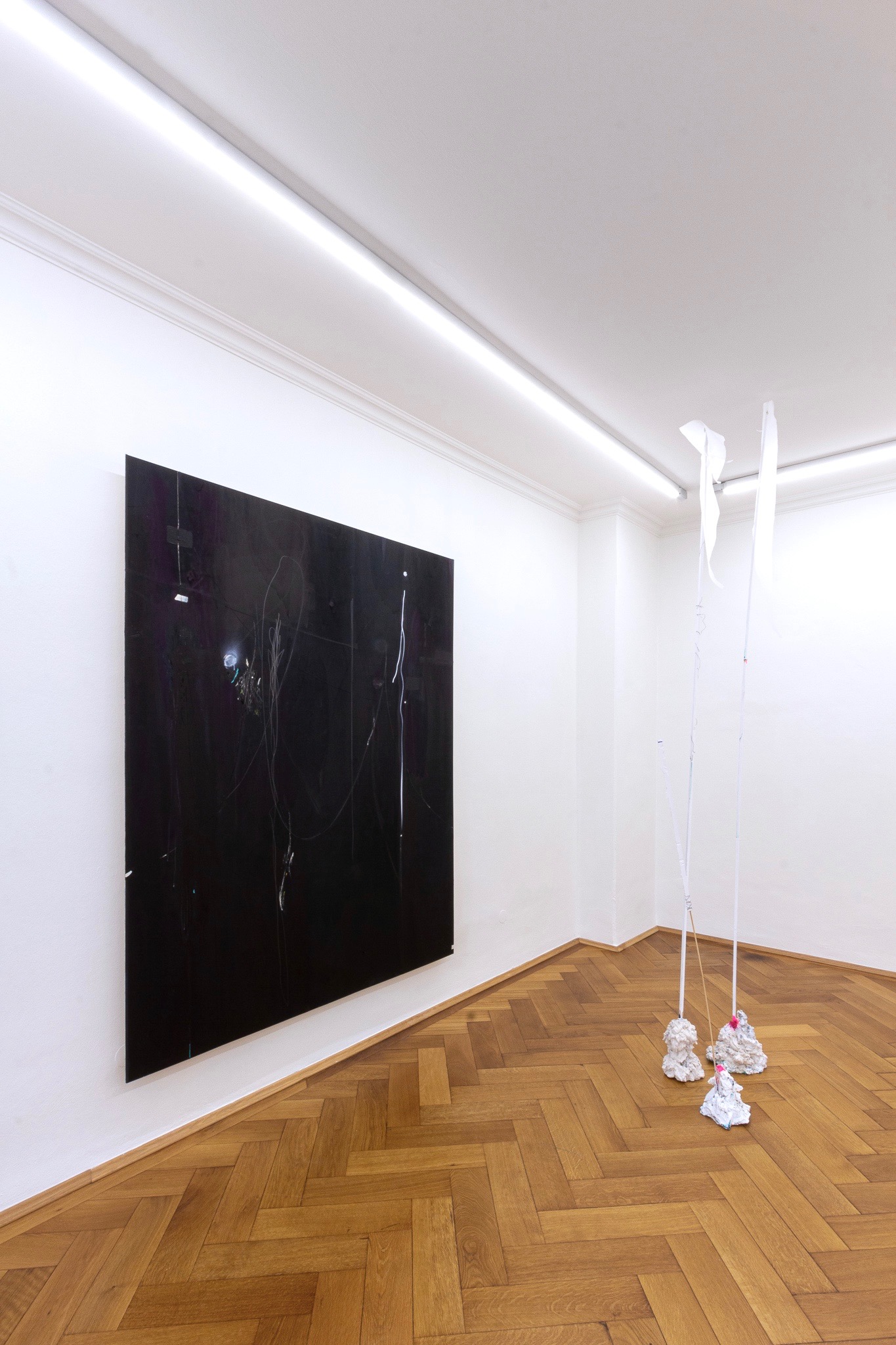Ephemeral traces of public spaces manifest themselves in the painterly positions of artist Simone Lanzenstiel. Taking up abstractions or fragments of our visual culture that she has found, such as faded graffiti on walls, the weathered facades of buildings or forgotten posters, she transforms these into spatially expansive painting. The title of her first solo exhibition with Britta Rettberg had already emphasized the aspect of temporality. It is about the kind of chance that sparks changes at the bat of an eye, about structures that are not intended to last forever, but which morph because they have been forgotten, because they have decayed or weathered.
The departure from conventional picture spaces as well as an emphasis on things unforeseen are just as essential to Simone Lanzenstiel’s art as her use of creative means that are not otherwise customary in art. The artist works with materials she has found, at first glance worthless, cast-off items, which she uses as picture carriers or for placing accents. In doing so, she keeps an eye out for mirror shards, plastic foils, newspaper fragments or things she finds in her studio, which are then given a new value as a result of her artistic intervention.
For her exhibition “augenblicklich” the Berlin-based artist is showing her new painterly positions on wood panels which, owing to a particular hanging device in the back, reveal themselves to the viewer as three-dimensional panel paintings that float before the wall.
Due to the grain of the wood, the wood panels shape the application of the paint, their lines becoming part of the composition and causing movement and dynamics to come about. Traditions of Abstract Expressionism and of Art Informel also enter into Simone Lanzenstiel’s painting compositions, which come about in a subtle balancing act between precision and consciously induced randomness. Upon the rough painting ground, amorphous cloud sprays encounter fine, graphic gestures, rendered for the most part in oil crayon or charcoal. These sharp, deliberately placed, compositional elements are redolent of things incidentally noted, of scribbles, or of graffiti on the walls of buildings, and conjure up associations with the calligraphic sign systems of Cy Twombly¹.
Using scalpels and various sandpapers, the artist breaks open the painting surface, exposing deeper-lying layers of paint beneath the painted surface. Due to these partial incisions and deepenings, the wood panel becomes a relief upon which the notches continue as painterly lines. This deliberate injury to the painting ground leaves unintended traces behind in Simone Lanzenstiel’s art, in which the processual nature is enhanced, and the painting may be understood as a physical act. The creative process of removing and adding takes on a sculptural character, and a charged relationship comes about between painting and plasticity. The picture levels that result from this make us think of Lucio Fontana’s incised paintings and his spatial concept.
By means of the colors, the reference to public life is carried further. The color spectrum ranges from pastel hues via signal colors such as neon orange or neon pink, which Simone Lanzenstiel places as accents. Shades of gray and white recall well-worn building facades. Compared to her earlier positions, the color white no longer functions for her as a non-color for correcting inconsistencies, but rather as an autonomous color tone. For the first time, the artist is presenting works in this exhibition that have been rendered completely in black with silvery shimmering pencil traces.
Simone Lanzenstiel’s works tell less of the inherent meanings of the materials than they do of their consistency – their fragility and transitoriness, by means of which the abstract structures take shape. Through subtle picture details, such as a piece of tape or newspaper snippets, the painting leaves its framework and spreads out in the volume of the room. Expansive, fragile picture spaces come about, which surmount their singularities through only minimal spatial interventions and present themselves at Britta Rettberg as an overall architectural concept. A line sprayed on the wall as an accent or a painted wooden slat cutting through the space is for the most part sufficient, changing the perception of the exhibition display. The boundaries between the ceiling and the floor are questioned and expanded with the aid of mirror shards. The result is walk-through narrations, which only open up to the viewers successively when they change, await and observe their respective viewing position.
¹ The French philosopher Roland Barthes wrote about the relationship between picture carrier and incision: “[…] It is known that what constitutes graffiti is not really the inscription, and not its message, either. It is the wall, the background, the panel; because the ground completely exists, like an object that has already lived, with the writing coming to it like a mysterious addition: that, which is superfluous, surplus, placeless, is what disturbs the order; […]”, see Barthes, Roland, “Cy Twombly”, Merve Verlag, Berlin, 1983, p. 22 (Translation: Elizabeth Volk).






